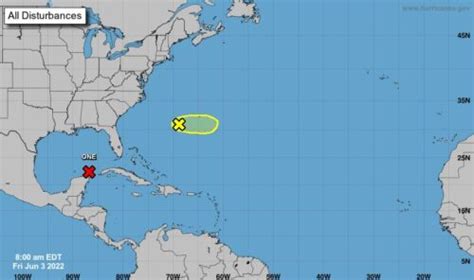
The Atlantic hurricane season is showing signs of heightened activity, prompting experts to emphasize the need for preparedness as conditions increasingly favor storm development. A confluence of factors, including exceptionally warm ocean temperatures and a developing La Niña pattern, are raising concerns about a potentially intense and active season.
The unusually warm Atlantic waters, significantly above average for this time of year, are providing a fertile breeding ground for tropical cyclones. These warm waters act as fuel, providing the energy necessary for storms to intensify rapidly. “The environment is primed,” stated a leading meteorologist. “We’re seeing ocean temperatures that are more typical of late August than mid-June, and that’s a significant concern.” This early and pronounced warming trend is a key factor driving the heightened risk assessment.
Compounding the concern is the anticipated emergence of a La Niña pattern in the Pacific Ocean. La Niña typically weakens the wind shear across the Atlantic basin. Wind shear, the difference in wind speed and direction at different altitudes, can disrupt the development of tropical cyclones by tearing them apart. With reduced wind shear, storms are more likely to form and intensify without facing as much resistance.
The combination of warmer waters and reduced wind shear creates a synergistic effect, significantly increasing the likelihood of an above-average hurricane season. Experts are closely monitoring these conditions and urging coastal communities to review their hurricane preparedness plans. This includes securing homes, stocking emergency supplies, and staying informed about potential threats.
Heightened Risk Factors
Several key factors are contributing to the elevated concern surrounding this year’s hurricane season:
-
Record-Breaking Ocean Temperatures: Atlantic sea surface temperatures are currently at record highs for this time of year, exceeding historical averages by a significant margin. This anomalously warm water provides an abundance of energy for tropical cyclones to draw upon, potentially leading to more rapid intensification and stronger storms.
-
La Niña Development: The impending La Niña pattern in the Pacific is expected to weaken vertical wind shear across the Atlantic basin. Weaker wind shear allows tropical disturbances to organize and intensify more easily, increasing the likelihood of hurricane formation and development.
-
Favorable Atmospheric Conditions: In addition to La Niña, other atmospheric factors, such as a weaker subtropical high-pressure system, could also contribute to a more conducive environment for hurricane development. A weaker high-pressure system can lead to reduced wind shear and more favorable steering currents, guiding storms towards land.
-
Pre-Season Activity: Even before the official start of the hurricane season, there have been instances of tropical cyclone formation in the Atlantic. While these early-season storms are not necessarily indicative of the overall season’s intensity, they do highlight the potential for early development and underscore the importance of preparedness.
Historical Context and Previous Seasons
Understanding the historical context of hurricane seasons can provide valuable insights into the potential severity of the upcoming season. By examining past seasons with similar characteristics, such as those with warm ocean temperatures and La Niña conditions, experts can better anticipate the types of storms that may develop and the potential impacts they could have.
For example, the 2005 hurricane season, which featured both warm Atlantic waters and a La Niña pattern, was one of the most active and destructive on record. It included Hurricane Katrina, which devastated New Orleans, and several other major hurricanes that caused widespread damage along the Gulf Coast. While every season is unique, studying past events can help inform preparedness efforts and mitigation strategies.
The 2020 Atlantic hurricane season was also exceptionally active, with a record-breaking number of named storms. That season also featured warm ocean temperatures and a developing La Niña pattern. The sheer number of storms strained resources and highlighted the need for improved forecasting and communication.
Preparedness Measures and Recommendations
Given the elevated risk factors, experts are strongly urging coastal residents to take proactive steps to prepare for the hurricane season. Preparedness is not a one-time event but an ongoing process that involves staying informed, developing a plan, and gathering necessary supplies.
-
Develop a Hurricane Preparedness Plan: A well-thought-out plan is essential for ensuring the safety and well-being of individuals and families during a hurricane. This plan should include evacuation routes, communication strategies, and designated meeting places. It should also address the specific needs of vulnerable populations, such as the elderly, individuals with disabilities, and families with young children.
-
Assemble an Emergency Supply Kit: An emergency supply kit should contain enough food, water, and other essential items to sustain individuals and families for several days. This kit should include non-perishable food items, bottled water, a first-aid kit, medications, a flashlight, a battery-powered radio, and extra batteries. It should also include personal hygiene items, such as soap, hand sanitizer, and toilet paper.
-
Secure Your Home: Taking steps to protect your home from hurricane-force winds and flooding can significantly reduce the risk of damage. This includes reinforcing doors and windows, trimming trees and shrubs, and clearing gutters and downspouts. It may also involve installing hurricane shutters or plywood covers to protect windows from flying debris.
-
Stay Informed: Staying informed about the latest weather forecasts and warnings is crucial for making timely decisions during a hurricane. This can be achieved by monitoring local news channels, following the National Hurricane Center’s website, and using weather apps on smartphones and tablets.
-
Know Your Evacuation Zone: Understanding your evacuation zone is essential for knowing when and where to evacuate during a hurricane. Evacuation zones are designated areas that are at high risk of flooding or storm surge. Local emergency management agencies provide information about evacuation zones and evacuation routes.
-
Review Insurance Coverage: It is important to review your insurance coverage to ensure that you have adequate protection against hurricane-related damages. This includes homeowners insurance, flood insurance, and windstorm insurance. It is also important to understand the deductibles and limitations of your insurance policies.
Economic and Societal Impacts
Hurricanes can have significant economic and societal impacts, affecting everything from property values and tourism to infrastructure and public health. The costs associated with hurricane damage can be substantial, including the expenses of repairing or rebuilding homes and businesses, providing emergency relief to affected communities, and addressing long-term health consequences.
The economic impacts of hurricanes can extend beyond the immediate disaster zone, affecting regional and national economies. Disruptions to supply chains, transportation networks, and tourism industries can have ripple effects that impact businesses and consumers across the country.
The societal impacts of hurricanes can be equally profound, leading to displacement, emotional distress, and long-term health problems. Displacement can disrupt communities and create challenges for individuals and families who are forced to relocate. Emotional distress can manifest as anxiety, depression, and post-traumatic stress disorder. Long-term health problems can include injuries, illnesses, and exposure to environmental hazards.
Government and Community Responses
Effective government and community responses are essential for mitigating the impacts of hurricanes and ensuring the safety and well-being of affected populations. These responses can include pre-disaster planning, emergency preparedness exercises, and post-disaster relief efforts.
Government agencies at the local, state, and federal levels play a critical role in hurricane preparedness and response. These agencies are responsible for developing and implementing emergency plans, issuing warnings and evacuations, coordinating relief efforts, and providing financial assistance to affected communities.
Community organizations, such as non-profit organizations, faith-based groups, and volunteer organizations, also play a vital role in hurricane preparedness and response. These organizations can provide assistance with evacuation, shelter, food distribution, and other essential services.
The Role of Climate Change
While it is difficult to attribute any single hurricane to climate change, scientists have observed a trend of increasing intensity and frequency of extreme weather events, including hurricanes. Climate change is causing ocean temperatures to rise, which provides more energy for tropical cyclones to develop and intensify. Climate change is also contributing to sea-level rise, which increases the risk of storm surge and coastal flooding.
Some studies suggest that climate change may also be affecting the track and speed of hurricanes, potentially leading to more unpredictable and damaging storms. While the exact impacts of climate change on hurricanes are still being studied, it is clear that climate change is exacerbating the risks associated with these events.
Long-Term Recovery and Resilience
The recovery from a hurricane can be a long and challenging process, requiring sustained efforts from individuals, communities, and governments. Long-term recovery involves rebuilding infrastructure, restoring economies, and addressing the social and emotional needs of affected populations.
Building resilience is essential for reducing the vulnerability of communities to future hurricanes and other disasters. Resilience involves strengthening infrastructure, improving emergency preparedness, and promoting community engagement. It also involves addressing the underlying factors that contribute to vulnerability, such as poverty, inequality, and environmental degradation.
Future Outlook
The future outlook for hurricane activity is uncertain, but most scientists agree that the risks are likely to increase in the coming years. Climate change is expected to continue to warm ocean temperatures and contribute to sea-level rise, which will exacerbate the impacts of hurricanes.
Improved forecasting and warning systems, as well as proactive preparedness measures, can help to reduce the risks associated with hurricanes. However, it is also essential to address the underlying causes of climate change and to build more resilient communities.
Staying Informed and Taking Action
Staying informed about the latest weather forecasts and warnings is crucial for protecting yourself and your family during a hurricane. This can be achieved by monitoring local news channels, following the National Hurricane Center’s website, and using weather apps on smartphones and tablets.
Taking action to prepare for a hurricane can make a significant difference in your ability to weather the storm safely. This includes developing a hurricane preparedness plan, assembling an emergency supply kit, securing your home, and knowing your evacuation zone.
By staying informed and taking action, individuals and communities can reduce their vulnerability to hurricanes and other disasters. The combined effect of warmer waters and reduced wind shear creates a synergistic effect, significantly increasing the likelihood of an above-average hurricane season. Experts are closely monitoring these conditions and urging coastal communities to review their hurricane preparedness plans. This includes securing homes, stocking emergency supplies, and staying informed about potential threats.
The importance of individual and community preparedness cannot be overstated. While forecasters can provide valuable information about potential threats, it is up to each person to take the necessary steps to protect themselves and their loved ones. This includes developing a hurricane preparedness plan, assembling an emergency supply kit, and staying informed about potential evacuation orders.
Local governments and emergency management agencies are also playing a critical role in preparing for the hurricane season. They are conducting drills, reviewing evacuation plans, and working to ensure that adequate resources are available to respond to potential emergencies. Collaboration between government agencies, community organizations, and individuals is essential for ensuring a coordinated and effective response to hurricanes.
Detailed Expansion on Key Areas
To fully grasp the gravity of the situation, let’s delve deeper into some of the key aspects mentioned above:
-
Ocean Temperatures: A Detailed Look
The Atlantic Ocean’s surface temperatures are not uniformly elevated; certain regions are experiencing particularly anomalous warmth. The Gulf of Mexico, the Caribbean Sea, and the Main Development Region (MDR) – the area between Africa and the Caribbean where many tropical cyclones originate – are all registering temperatures well above average. The MDR, in particular, is crucial because it’s the “nursery” for many major hurricanes. When water temperatures in the MDR are significantly warmer than normal, it provides a substantial boost to developing storms.
Scientists use sea surface temperature (SST) anomalies to quantify these deviations from the norm. An SST anomaly represents the difference between the current SST and the average SST for that location and time of year, calculated over a long-term historical period (usually 30 years). Positive SST anomalies indicate that the water is warmer than usual, while negative anomalies indicate cooler water. The current positive SST anomalies in the Atlantic are not just slightly above average; they are breaking records in some areas.
This excess heat translates directly into available energy for hurricanes. Hurricanes are essentially heat engines, converting the heat energy from the ocean into the kinetic energy of wind and rain. The warmer the water, the more energy is available, and the stronger the storm can become. This is why rapid intensification – a process where a hurricane’s wind speeds increase dramatically in a short period – is more likely when storms encounter unusually warm waters.
-
La Niña’s Impact: A Deep Dive
La Niña is a climate pattern characterized by cooler-than-average sea surface temperatures in the central and eastern equatorial Pacific Ocean. This cooling has far-reaching effects on global weather patterns, including the Atlantic hurricane season. One of the most significant impacts of La Niña on the Atlantic is the reduction of vertical wind shear.
Vertical wind shear is the change in wind speed and direction with altitude. Strong wind shear can disrupt the organization of a tropical cyclone, tearing apart its structure and preventing it from intensifying. Think of it like a spinning top: if you bump it from the side, it will wobble and eventually fall over. Wind shear has a similar effect on hurricanes.
La Niña weakens the subtropical jet stream, a high-altitude wind current that can bring strong wind shear to the Atlantic basin. With a weaker jet stream, wind shear is reduced, allowing tropical disturbances to develop more freely into tropical storms and hurricanes. Furthermore, La Niña can also enhance the convergence of air in the lower atmosphere over the Atlantic, which promotes the upward motion needed for storm formation.
-
The Role of the Subtropical High
The subtropical high, also known as the Bermuda High or Azores High, is a semi-permanent high-pressure system located in the Atlantic Ocean. Its position and strength influence the steering currents that guide hurricanes. A weaker-than-normal subtropical high can allow hurricanes to move closer to the U.S. East Coast and potentially make landfall. The location of the high determines the general track that hurricanes will take. If the high is positioned further east, it tends to steer hurricanes away from the U.S. coast. However, if it is positioned further west, it can push hurricanes towards the coast. The intensity of the high also plays a role; a weaker high offers less resistance, allowing storms to move more freely.
-
Rapid Intensification: A Growing Threat
Rapid intensification (RI) is a phenomenon where a tropical cyclone’s maximum sustained winds increase by at least 35 mph (56 km/h) within a 24-hour period. RI can make hurricanes particularly dangerous because it gives coastal communities less time to prepare for the storm’s arrival. Historically, RI was difficult to predict, but advances in forecasting models have improved our ability to anticipate this phenomenon. However, RI remains a significant challenge for hurricane preparedness because it can quickly turn a manageable situation into a catastrophic one. The warm ocean temperatures are more likely to cause RI.
-
The Importance of Accurate Forecasting
Accurate forecasting is essential for providing timely warnings and allowing communities to prepare for approaching hurricanes. The National Hurricane Center (NHC) uses a variety of tools and techniques to forecast hurricane tracks and intensity, including satellite imagery, weather models, and reconnaissance aircraft. While forecasting has improved significantly in recent decades, there are still limitations, particularly in predicting rapid intensification and the exact location of landfall. Continuing research and development are focused on improving these areas. The ‘spaghetti models’ are often used to forecast the track of a hurricane. These models use the ensemble forecast to determine the path of a hurricane.
-
Community-Level Preparedness: A Call to Action
Preparedness is not just about individuals stocking up on supplies; it’s about building resilience at the community level. This includes strengthening infrastructure, improving communication systems, and training volunteers to assist in disaster response. Community-based organizations play a critical role in reaching vulnerable populations and ensuring that everyone has access to the resources they need to prepare for and recover from hurricanes.
Furthermore, effective preparedness requires coordination between government agencies, non-profit organizations, and the private sector. This includes developing joint emergency plans, conducting joint training exercises, and sharing resources during a disaster. A whole-community approach is essential for building resilience and minimizing the impacts of hurricanes.
-
Insurance Considerations: Protecting Your Assets
Homeowners insurance typically covers damage from wind, but it often excludes flood damage. Flood insurance is usually a separate policy offered through the National Flood Insurance Program (NFIP). It’s crucial for homeowners in coastal areas to have flood insurance, even if they are not located in a designated flood zone, because hurricanes can bring torrential rainfall and widespread flooding.
Windstorm insurance may also be necessary in some coastal areas, particularly those prone to high winds. These policies typically cover damage from wind-driven rain and debris. It’s important to review your insurance policies carefully to understand what is covered and what is not. It’s also important to document your property before a hurricane, taking photos and videos of your home and belongings. This documentation can be helpful when filing insurance claims after a storm.
-
The Psychological Impact of Hurricanes
The psychological impact of hurricanes can be significant and long-lasting. Survivors may experience anxiety, depression, post-traumatic stress disorder (PTSD), and other mental health problems. Children are particularly vulnerable to the psychological effects of hurricanes.
It’s important for individuals and communities to have access to mental health services after a hurricane. This includes counseling, support groups, and other resources. It’s also important to be aware of the signs of psychological distress and to seek help when needed.
-
The Role of Technology in Hurricane Preparedness
Technology plays an increasingly important role in hurricane preparedness. Smartphones, weather apps, and social media can provide real-time information about approaching storms and help people stay connected during a disaster. Satellite imagery and weather models provide forecasters with valuable data for predicting hurricane tracks and intensity.
Drones and other unmanned aerial vehicles can be used to assess damage after a hurricane and to deliver supplies to affected communities. Technology can also be used to improve communication systems and to coordinate disaster response efforts.
-
The Impact of Hurricane Preparedness on Tourism
Tourism is an industry that is often directly affected by hurricanes. Coastal areas are popular tourist destinations, but they are also vulnerable to hurricanes. Hurricane preparedness can help to minimize the impact of hurricanes on tourism by protecting infrastructure, reducing damage, and ensuring the safety of visitors.
When a hurricane threatens a tourist destination, it’s important for businesses to have a plan in place to protect their property and their employees. This includes securing buildings, evacuating visitors, and communicating with guests about the storm. It’s also important to have insurance coverage to protect against losses.
Frequently Asked Questions (FAQ)
-
What makes this hurricane season potentially more dangerous than usual?
The combination of record-breaking warm Atlantic ocean temperatures and the anticipated development of a La Niña pattern is causing concern. Warmer waters fuel storm intensity, while La Niña weakens wind shear, allowing storms to develop more easily. “The environment is primed,” as some meteorologists have noted, indicating a higher risk of stronger and more frequent storms.
-
How does La Niña affect hurricane activity in the Atlantic?
La Niña, characterized by cooler-than-average sea surface temperatures in the central and eastern Pacific Ocean, typically weakens the wind shear in the Atlantic. Wind shear can disrupt developing storms, so a reduction in shear allows tropical disturbances to organize and intensify into hurricanes more readily.
-
What are the most important steps I can take to prepare for a hurricane?
Develop a hurricane preparedness plan that includes evacuation routes and communication strategies, assemble an emergency supply kit with food, water, and essential items, secure your home by reinforcing doors and windows, and stay informed about weather forecasts and warnings. Know your evacuation zone and review your insurance coverage.
-
Where can I find reliable information about hurricane forecasts and warnings?
Reliable sources of information include the National Hurricane Center (NHC) website (www.nhc.noaa.gov), local news channels, and weather apps on smartphones and tablets. The NHC provides official forecasts, warnings, and advisories for tropical cyclones in the Atlantic and Eastern Pacific.
-
What kind of insurance coverage do I need to protect myself from hurricane damage?
Homeowners insurance typically covers wind damage, but flood damage is usually excluded. Consider obtaining a separate flood insurance policy through the National Flood Insurance Program (NFIP) if you live in a coastal area. Windstorm insurance may also be necessary in some regions. Review your policies carefully to understand your coverage.
The Atlantic hurricane season demands serious attention and proactive preparation. The confluence of warm ocean temperatures and a looming La Niña pattern presents a heightened risk of increased storm activity. Coastal communities and individuals must heed expert warnings, review preparedness plans, and take necessary steps to protect themselves and their property. Staying informed, being prepared, and working together are crucial for mitigating the potential impacts of what could be a challenging hurricane season.









